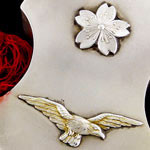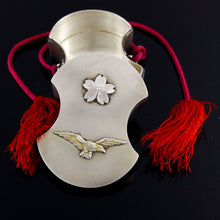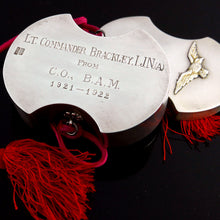Japanese Presentation Gift From a British Traitor to a Pioneer Aviator, 1921-22
Adding product to your cart
Overall: 2.5cm x 6.6cm x 5cm
A Japanese presentation silver box, the cover applied with silver cherry blossom motif over Naval Air Service eagle volant with head lowered to sinister, the sides tied with red cord, the reverse inscribed 'Lt. Commander Brackley, I.J.N.(A) [Imperial Japanese Navy (Attached)] from C.O. [Commanding Officer], B.A.M. [British Air Mission] 1921 -1922'. Hallmarked gunjin (pure silver). Maker’s name of Murata,
Read more
In September 1921 Captain the Master of Sempill led a British Air Mission, composed of former naval airmen including Lieutenant-Commander Brackley to Japan. The objective of the eighteen month Mission was to help the Imperial Japanese Navy to develop its air arm. The Japanese were trained on several new aircraft and in torpedo bombing and flight control. The Mission also brought the plans the British aircraft carriers, Argus and Hermes, which influenced the final stages of the development of the Japanese carrier Hōshō, that in 1941 provided cover for the forces attacking Pearl Harbor. With the termination of the Anglo-Japanese Alliance in 1921-22, Sempill presented the present box to Brackley and at about the same time received a personal letter from the Japanese Prime Minister, thanking him for his work with the Imperial Navy which he described as ‘almost epoch-making.’
On his return home Sempill should have terminated contact with the Japanese but he kept in touch through the naval attaché at the Japanese embassy in London. MI5 surveillance soon showed the old Etonian aristocrat was passing classified information to the Japanese in exchange for payment. Sempill's phone was tapped and it was further noted that his man servant was a Japanese naval rating.
The 19th Lord Sempill’s treachery culminated in passing details to the Japanese of the meeting between Churchill and Roosevelt aboard H.M.S. Prince of Wales in August 1941. Acting on the evidence of Bletchley Park intercepts, Churchill signed a note in October that read 'Clear him out while time remains'. Nevertheless Lord Sempill survived at the Admiralty until 13 December 1941, six days after Pearl Harbor, when his office was raided. Yet despite the evidence of treason in wartime, no arrest or prosecution was ordered and Sempill agreed to retire from public office.
Air Commodore H.G. ‘Brackles’ Brackley, D.S.O., D.S.C. (1894-1948) was a First World War bomber pilot and pioneer aviator. In 1919 he went to Newfoundland with a Handley Page night flying heavy bomber in order to attempt the trans-Atlantic crossing. Beaten in the attempt by Alcock and Brown, he flew the other way and completed the first flight from Newfoundland to New York, accompanied by Admiral Mark Kerr. He also completed a number of other record breaking flights in America.
In 1921 he joined the Sempill Mission as an Air Adviser to the Japanese Naval Air Service, and according to his published biography was seen as a useful conduit for passing technical information to the Japanese when he returned to Britain on leave in July 1922. However it is unclear what action he took, the choices being to refuse to have anything with the request (difficult, given his employment status); gather information for the Japanese or tell MI5.
In 1924, he joined the newly formed Imperial Airways, planning operations and in 1926 made the first scheduled flight from London to Paris. He also surveyed the route for flying boats between England and Australia, recommending that large distances could be flown overland. Recalled to wartime service in 1939, he filled senior posts in Coastal Command and Transport Command. At the end of the war, he returned to the civilian aviation. Amongst his post-war achievements was the successful evacuation of 35,000 people from India to Pakistan following the partition of India. In 1948 he was appointed Chief Executive of British South American Airways
. On a stop over in Rio de Janeiro during a tour of South America he drowned whilst swimming.








